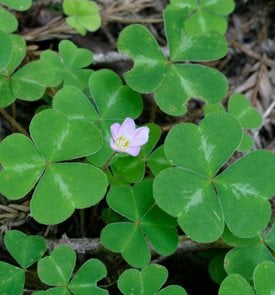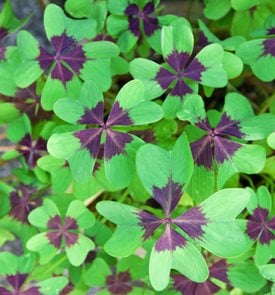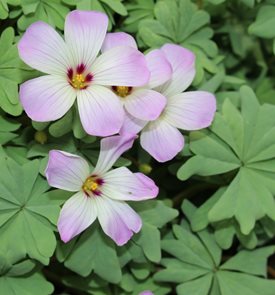A GUIDE TO GROWING SHAMROCK PLANTS (OXALIS)
Bring a bit of good fortune into your home or garden with captivating, easy-to-grow, false shamrock plants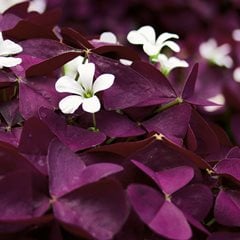
Charmed® Wine Shamrock. Photo by: Proven Winners.
Oxalis, a member of the wood sorrel family, often gets a bad rap because of its weedy reputation. While it’s true that some native species can quickly overrun a lawn or garden, there are many ornamental varieties that are well-behaved and full of charm. With colorful clover-like leaves and dainty flowers, oxalis are superb accent plants in garden beds and containers. Many oxalis are also perfectly happy as house plants, especially in areas with colder winters.
Although you will often find oxalis sold in garden centers as “shamrock plants,” especially around St. Patrick’s Day, they are not true shamrocks or relatives of clover, despite the similarities in leaf form. Oxalis has a personality all its own, flaunting three-lobed, triangular leaves in rich shades ranging from emerald green to deep maroon and even variegated patterns. You’ll also find some varieties sporting an extra leaf for good measure, just like the lucky four-leaf clover.
On this page: Basics | Planting Oxalis | Oxalis Care and Maintenance | Growing Oxalis Indoors | Pothos Pictures | Garden Ideas
- BASICS
- PLANTING OXALIS
- OXALIS CARE AND MAINTENANCE
- GROWING OXALIS INDOORS
- OXALIS VARIETIES
- USING OXALIS IN THE GARDEN
OXALIS BASICS
Botanical name:
Oxalis species.
Common names:
Wood sorrel, false shamrock, shamrock plant, good luck plant, love plant
Plant type:
Tender bulb, often grown as an annual or indoor plant.
Zones:
USDA Zones 7-10, although some varieties can tolerate colder temperatures.
Exposure:
Full sun to partial shade
Bloom time:
Virtually ever-blooming, with the heaviest flower production in the cooler temperatures of early spring and autumn. Plants tend to rest in the summer when temperatures exceed 85°F.
Flower colors:
There are white, pink, rose, lavender, or yellow-flowered varieties, as well as some with two-toned flowers.
Foliage colors:
Green, purple, silver, or variegated
Is oxalis toxic?
All members of the Oxalis genus contain oxalic acid, which can be toxic when ingested in large quantities. Keep plants away from children and pets. See more Common Poisonous Plants for Dogs and Cats.
Is oxalis invasive?
Some native species of oxalis, such as yellow wood sorrel (O. stricta) and creeping wood sorrel (O. corniculata), are common weeds and considered to be invasive. However, the ornamental varieties featured here are easily contained and will not spread out of bounds.
PLANTING OXALIS
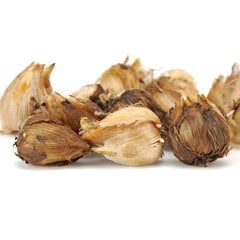
Oxalis bulbs. Photo by: de2marco / Shutterstock
Where to plant:
In full sun or light shade in well-drained, fertile soil. If you live in a hot climate, plants will do best in a location with afternoon shade.
When to plant:
Plant bulbs outdoors in late spring, after all danger of frost has passed. The foliage typically emerges 3 to 4 weeks after planting, with the flowers appearing approximately 8 to 10 weeks later.
How to plant:
In garden beds, plant bulbs approximately 2 inches deep and 4 to 6 inches apart, covering lightly with soil. If necessary, dig a little compost or organic matter into the soil before planting to improve soil quality.
For container plantings, plant the bulbs about an inch deep in a well-draining potting mix, using about 6 to 8 bulbs for a 6-inch pot.
Forcing oxalis bulbs:
You can also force potted oxalis bulbs indoors before moving them out to the garden by placing them in bright light in a room with cool temperatures (about 55° to 60°F). Keep the soil evenly moist, but not drenched. Once blooms begin to appear, they will often continue for several months. Unlike hardy bulbs, oxalis bulbs don’t need a cooling period (or vernalization) in order to grow.
OXALIS CARE AND MAINTENANCE
Watering:
Oxalis plants will wilt if the soil is allowed to dry out, so keep the soil evenly moist but not soggy. The bulbs will rot in overly wet soil.
Fertilizing:
If grown in well-composted soil, oxalis rarely needs additional plant food. Container-grown plants will benefit from the application a slow-release fertilizer at planting time. Withhold fertilizing if plants enter a resting or dormancy period in midsummer.
Pruning and deadheading:
Plants are self-cleaning, so no deadheading is necessary, but you can lightly prune the foliage at any time to control plant size and shape. If your plants go dormant in the summer and the leaves begin to turn brown, you can trim back the dying foliage to about an inch from base of the plant.
Overwintering:
In areas colder than zone 7, dig up bulbs planted in garden beds before the first frost and store them in a cool, dry place until they can be replanted in the spring. For shamrock plants grown in pots, move them indoors and stop watering them. Store them in a cool, frost-free place to keep them dormant. At the beginning of the next growing season, you can repot the bulbs and resume watering and fertilizing.
Pests and diseases:
Oxalis have few pests, but be on the lookout for aphids, whiteflies, and spider mites, which may occasionally be a nuisance. Other potential problems include fungal leaf spot, rust, and powdery mildew.
GROWING OXALIS INDOORS

. Charmed® Wine Shamrock. Photo by: Proven Winners
Light requirements:
Give bright, indirect light, such as from a south- or west-facing window. Under low-light conditions, plants may become spindly and fail to bloom.
Ideal room temperature:
Cool night temperatures (around 50° to 65°F) and warm daytime temperatures (around 70° to 75°F).
Humidity:
Average household humidity levels are fine.
Watering:
Keep soil evenly moist, watering when the surface of the soil feels dry. Pots should have drainage holes to prevent soggy soil.
Fertilizing:
Feed every 2 to 3 weeks with a balanced liquid house plant fertilizer while plants are actively growing.
Dormancy:
If your indoor oxalis begins to lose all of its leaves, don’t panic. It’s just entering a period of dormancy (which usually lasts for a month or two) so it can conserve energy for a new flush of growth. During this time, move your plant into a dark place, reduce watering, and stop fertilizing until you see new growth begin. This dormancy period is a good opportunity to divide plants by separating some of the bulbs and replanting them in new pots.
OXALIS VARIETIES
USING OXALIS IN THE GARDEN
There are many ways to use oxalis in the garden, including: rock gardens, groundcover, edging or front of border, or in containers and hanging baskets.
Fun fact:
Ever wondered why some oxalis are called "butterfly shamrocks”? That’s because their leaves are photophilic, which means they respond to light intensity by folding up at night or on overcast days and reopening when the sun shines. During the day, they may even stretch or change the position of their leaves to capture as much sunlight as possible.
RELATED:
A Shamrock's Meaning
21 Best Indoor Plants
14 Ground Cover Plants for Shade or Sun

